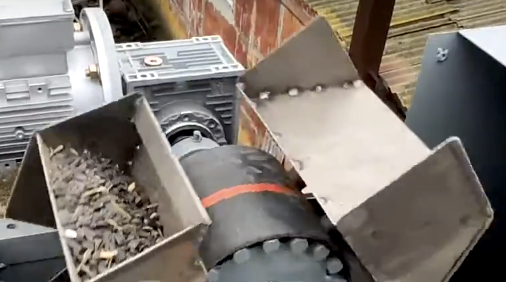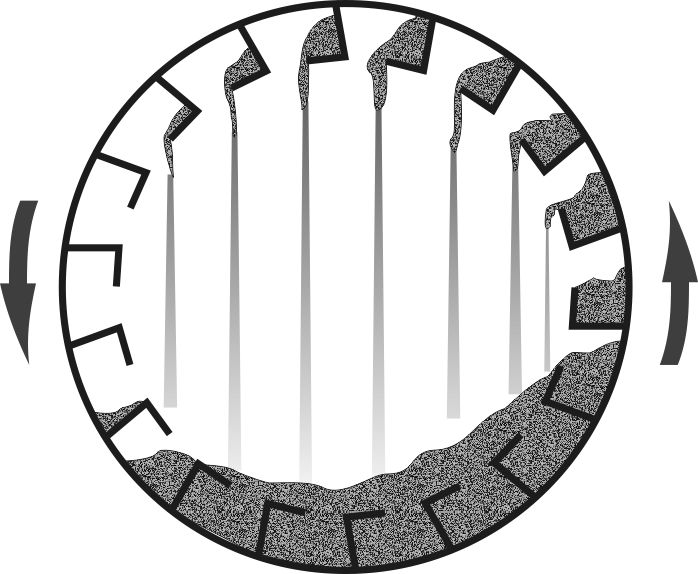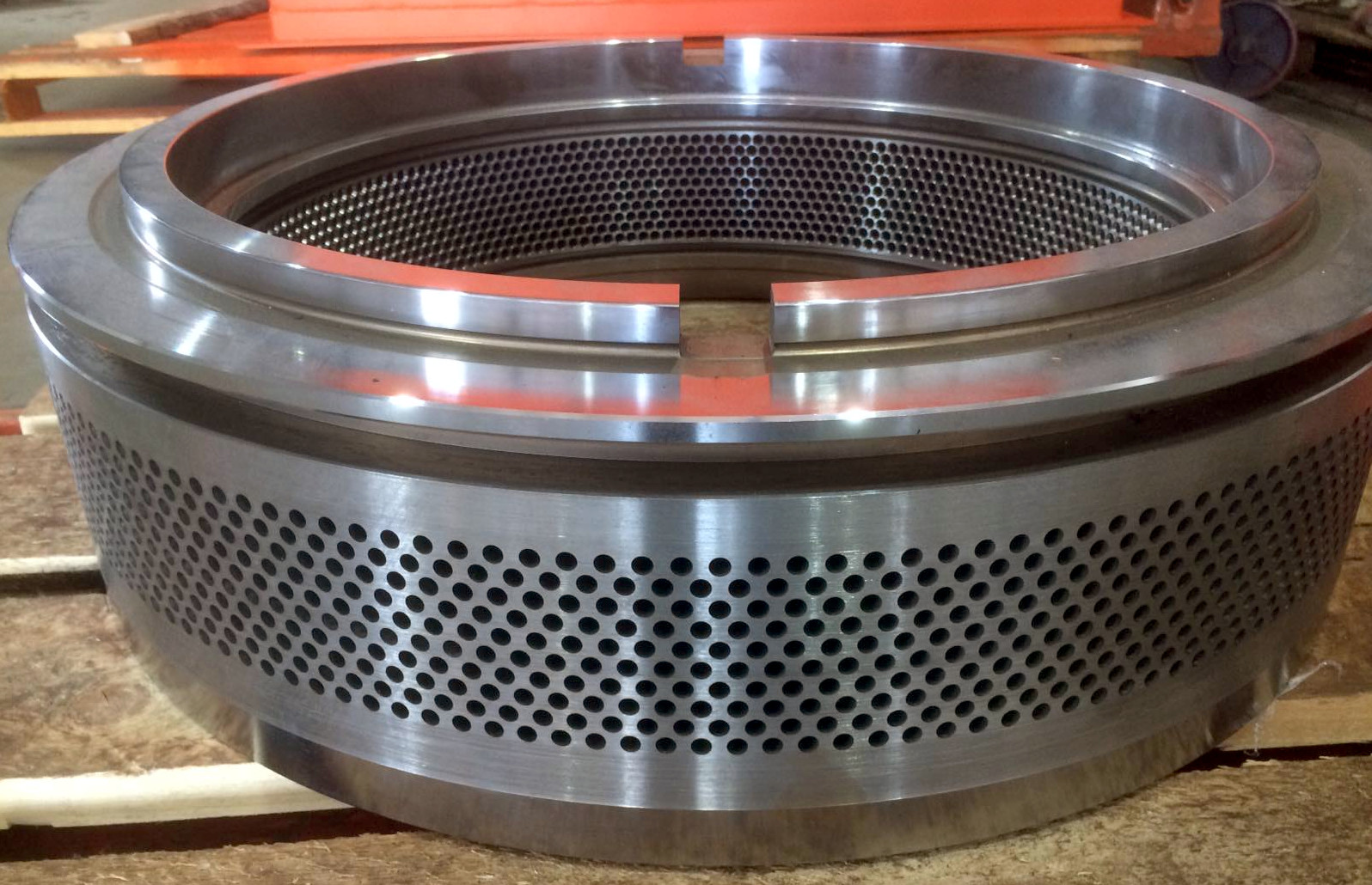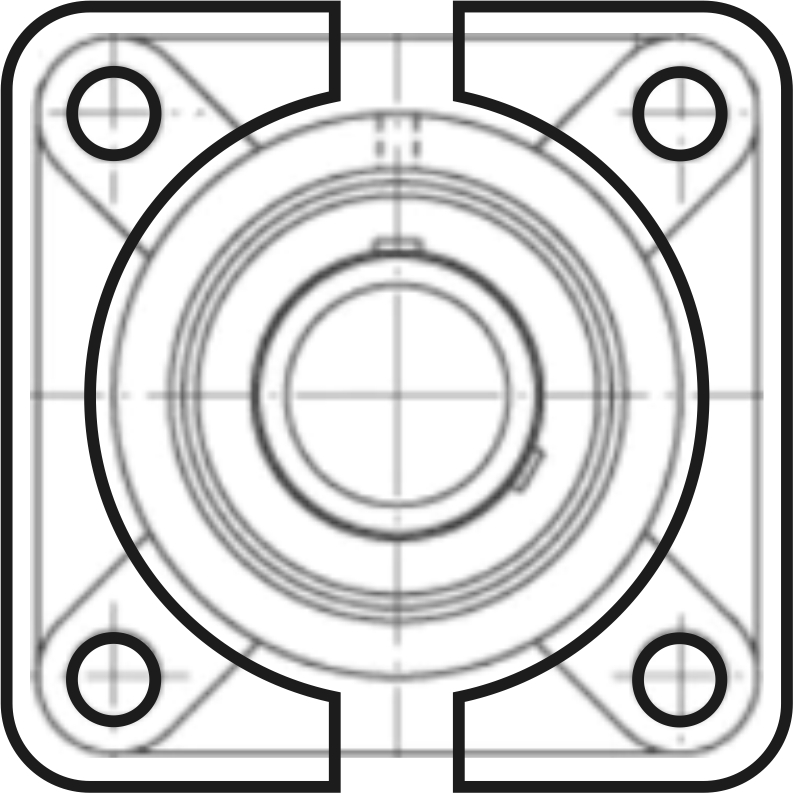Belt-scraper conveyors are most commonly used for gentle movement of finished or nearly finished products. Corrugated edges prevent spillage of pellets, while paddles allow the transport of large masses without significant mechanical stress.
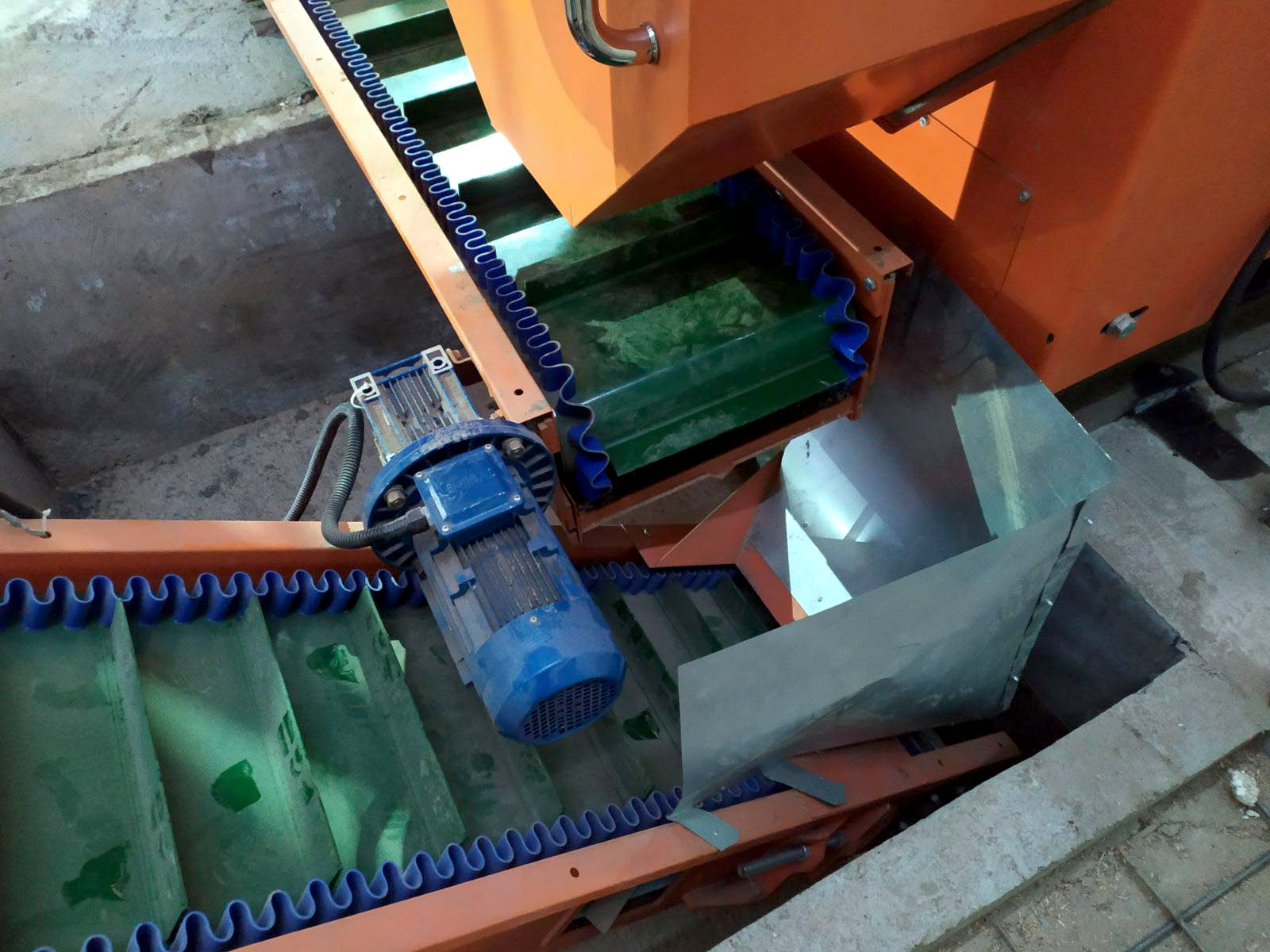 In most cases, these conveyors use a PVC belt with 2-3 layers of cord. The working side is glossy, while the underside is covered with a special wear-resistant fabric, which has a relatively low friction coefficient against a polished steel bed. Friction is further reduced by having drums protrude 5-10mm (0.2-0.4 inches) above the rest of the surface so that the first and last meter of the belt does not contact the frame when properly tensioned. For belts up to 300mm (12 inches) wide, intermediate support rollers are not used, but for belts 500mm (20 inches) and wider, intermediate rollers may be installed every 2 meters (7 feet) on conveyors that are 6 meters (20 feet) or longer, significantly reducing the load on the drive and saving a bit of electricity.
In most cases, these conveyors use a PVC belt with 2-3 layers of cord. The working side is glossy, while the underside is covered with a special wear-resistant fabric, which has a relatively low friction coefficient against a polished steel bed. Friction is further reduced by having drums protrude 5-10mm (0.2-0.4 inches) above the rest of the surface so that the first and last meter of the belt does not contact the frame when properly tensioned. For belts up to 300mm (12 inches) wide, intermediate support rollers are not used, but for belts 500mm (20 inches) and wider, intermediate rollers may be installed every 2 meters (7 feet) on conveyors that are 6 meters (20 feet) or longer, significantly reducing the load on the drive and saving a bit of electricity.
The drums are generally cylindrical in shape, because the belt touches the sides of the frame along its length or has a gap of up to 5mm (0.2 inches). Notably, with an almost perfect frame geometry and a gap between the belt and the frame edge of 1mm (0.04 inches), corrugated edges are not necessary for transporting pellets. With larger gaps, sawdust, dust, and other small debris accumulate under the belt, sticking to the bed, which eventually leads to either belt breakage or stopping. The width of the belt is often made to precisely match the width of the metal frame bed, causing the belt to wear by 1-3mm (0.04-0.12 inches) along the edge. The cord fibers help remove dust and prevent material buildup under the belt. If the gap is too large, it is cheaper to make side extensions for the conveyor than to reorder the belt.
Despite the slippery fabric backing, the belt adheres well to smooth steel drums with proper tension. Polyurethane or rubber drum linings can cause more problems than benefits as they tend to peel off, chip away, and increase friction between the covering fibers. Tensioning a solid rubber sleeve over a glue-coated drum is also a weak solution, as the glue takes a long time to dry in such depth, and in operation, the sleeve tends to slip to one side, damaging the bearing or drive.
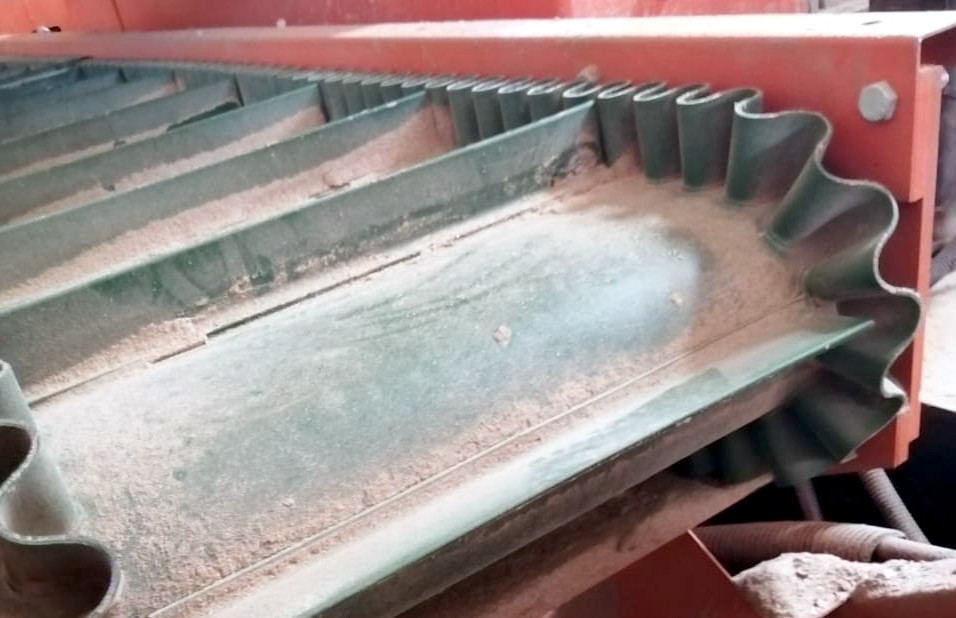 The minimum drum diameter is restricted for both the main belt and the corrugated edges with paddles. Failure to follow recommendations results in rapid belt and component degradation, especially when transporting hot pellets. Therefore, it is not advisable to economize on the pipe diameter in the preparations.
The minimum drum diameter is restricted for both the main belt and the corrugated edges with paddles. Failure to follow recommendations results in rapid belt and component degradation, especially when transporting hot pellets. Therefore, it is not advisable to economize on the pipe diameter in the preparations.
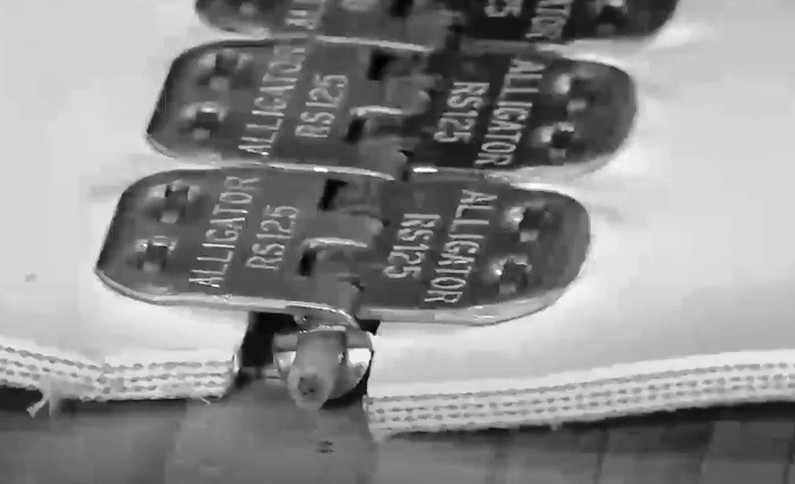 Such belts are connected using Alligator-type lacing, TM5Bricks, U45, among many other kinds, which allow joining two edges without losing elasticity and being sufficiently thin. Since these fasteners are applied at the edge, a common mistake is the complete removal of the corrugated edge when connecting. Then, over time, pellets slip past the edge, accumulate under the belt, sawdust layers on the drum, and eventually, everything becomes problematic. Therefore, it is sufficient to trim the corrugated edge from the main part of the belt, and after fastening, you can also sew the edge together. These fasteners usually use a wire with a polymer coating, which deforms and gets securely stuck in the fastener when the belt is tightened. The clamping of wire ends with a deformed washer is quite controversial because sooner or later the washer slides off the edge. If the wire is lost or if the belt is initially intended for reuse by piecing together surviving segments, it is much more practical to insert an appropriately sized steel wire slightly shorter in length for fixing, for which you should slightly squeeze the outer loops. This option may not look as neat, but it's just as reliable as the wire.
Such belts are connected using Alligator-type lacing, TM5Bricks, U45, among many other kinds, which allow joining two edges without losing elasticity and being sufficiently thin. Since these fasteners are applied at the edge, a common mistake is the complete removal of the corrugated edge when connecting. Then, over time, pellets slip past the edge, accumulate under the belt, sawdust layers on the drum, and eventually, everything becomes problematic. Therefore, it is sufficient to trim the corrugated edge from the main part of the belt, and after fastening, you can also sew the edge together. These fasteners usually use a wire with a polymer coating, which deforms and gets securely stuck in the fastener when the belt is tightened. The clamping of wire ends with a deformed washer is quite controversial because sooner or later the washer slides off the edge. If the wire is lost or if the belt is initially intended for reuse by piecing together surviving segments, it is much more practical to insert an appropriately sized steel wire slightly shorter in length for fixing, for which you should slightly squeeze the outer loops. This option may not look as neat, but it's just as reliable as the wire.
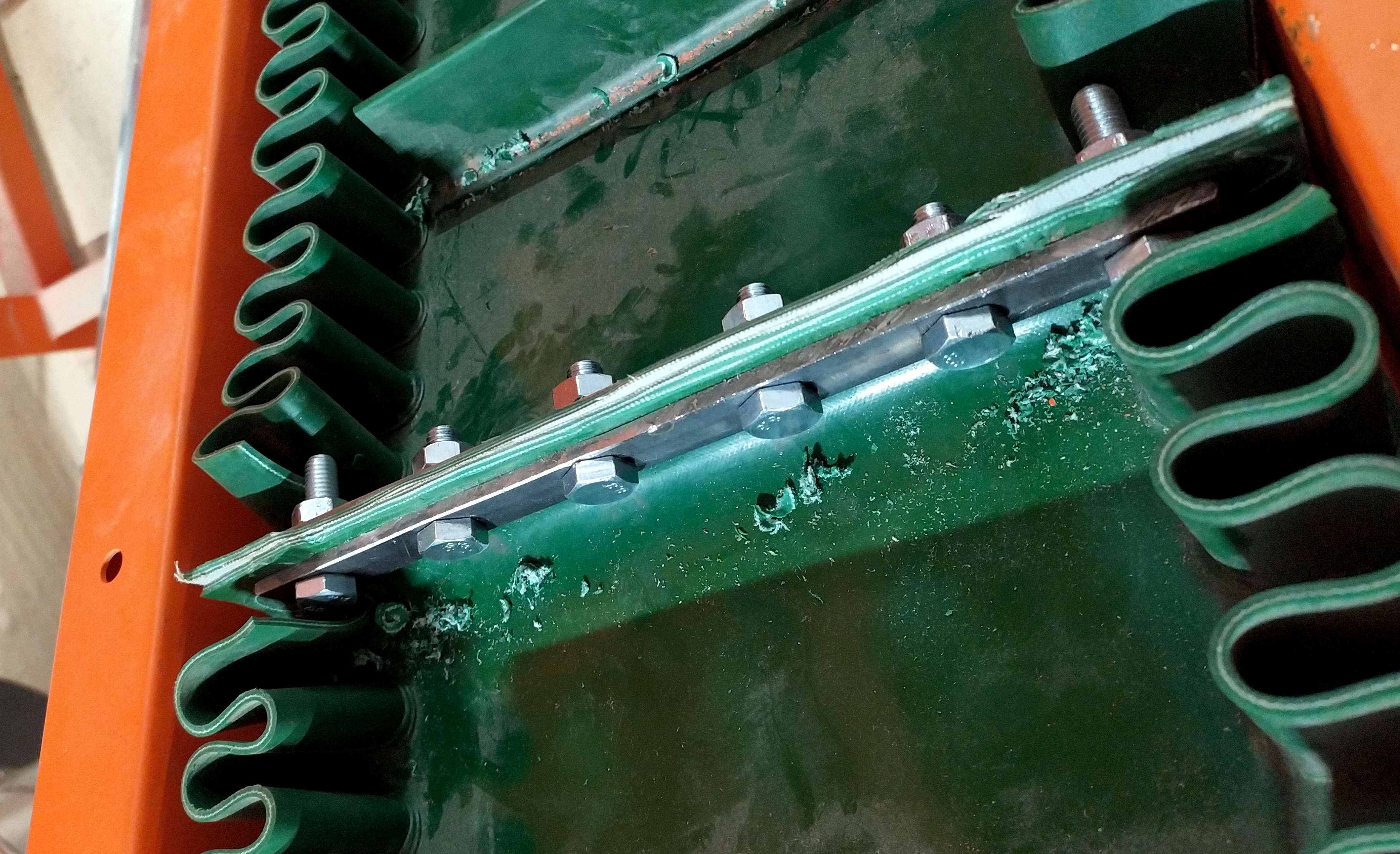 On the other hand, in the pellet industry, variants with corrugated edges and paddles are almost always used. Therefore, connecting with two plates with edges turned outward, as described in the previous section, is much more convenient here. The fastener also forms an additional paddle and is reusable. It is better to prepare a couple of dozen of such plates in advance as they make it possible to quickly integrate belt pieces for repair without a long factory shutdown.
On the other hand, in the pellet industry, variants with corrugated edges and paddles are almost always used. Therefore, connecting with two plates with edges turned outward, as described in the previous section, is much more convenient here. The fastener also forms an additional paddle and is reusable. It is better to prepare a couple of dozen of such plates in advance as they make it possible to quickly integrate belt pieces for repair without a long factory shutdown.
If the conveyor inclination is up to 40°, both paddles and corrugated edges are made the same height of 30 or 50 mm (1.2 or 2 inches). With greater inclination, the corrugated edge is made higher than the paddles to prevent pellet spillage on the floor. Using bent paddles like L-profiles is inefficient for pellets, and increasing productivity is much more predictable by increasing the number of paddles or the belt speed.
The table contains calculations for a bulk density of 600 kg/m³ (37 lb/ft³), assuming that the cross-section of each heap on the belt is conditionally in the form of an isosceles right triangle, where the leg is the height of the paddle. Of course, the pellets can hold significantly more on such a belt, but achieving an even distribution is practically impossible.
| Conveyor Name | Paddle Width, mm (in) | Belt Speed, m/s (ft/s) | Paddle Height, mm (in) | Volume for 1 Scraper, L (gal) | Capacity, t/h, at 40°, with 200 mm (8 in) step | Capacity, t/h, at 40°, with 150 mm (6 in) step | Capacity, t/h, horizontal |
|---|---|---|---|---|---|---|---|
| KLS-200 | 150 (6) | 0.4 (1.3) | 30 (1.2) | 0.135 (0.036) | 0.6 | 0.8 | 4 |
| KLS-200 | 150 (6) | 0.6 (2) | 30 (1.2) | 0.135 (0.036) | 0.9 | 1.2 | 6 |
| KLS-300 | 200 (8) | 0.4 (1.3) | 30 (1.2) | 0.18 (0.047) | 0.8 | 1.0 | 5 |
| KLS-300 | 200 (8) | 0.6 (2) | 30 (1.2) | 0.18 (0.047) | 1.2 | 1.6 | 8 |
| KLS-300 | 200 (8) | 0.4 (1.3) | 50 (2) | 0.5 (0.13) | 2.2 | 2.9 | 9 |
| KLS-300 | 200 (8) | 0.6 (2) | 50 (2) | 0.5 (0.13) | 3.2 | 4.3 | 13 |
| KLS-500 | 400 (15.7) | 0.4 (1.3) | 50 (2) | 1 (0.26) | 4.3 | 5.8 | 17 |
| KLS-500 | 400 (15.7) | 0.6 (2) | 50 (2) | 1 (0.26) | 6.5 | 8.6 | 26 |
Further increasing the speed can help reach any performance target, but 0.6 m/s (2 ft/s) is the limit beyond which controlling bouncing and scattering of pellets becomes more challenging. It's advisable to choose blade heights from the popular sizes and to adjust the performance by the frequency of their placement and the belt width. It's unlikely to save much here, so choose a width that fits well within the machine's dimensions and follow the belt manufacturer's recommendations for frequency. Placing scrapers too close together can add rigidity to the belt, which may require an increase in drum diameter. Too close blade placement increases the load on the belt and can lead to the drive drum slipping, while tightening the belt more can likely damage the bearings. If a compact and high-performing conveyor is needed, the belt should be welded instead of using locks, and the conveyor design should allow for such belt installation and accommodate much higher load tension on the drums.
 In the food industry, conveyors with bends are very popular. They start horizontally, have an inclined middle section, and then become horizontal at the top again. This reduces the number of drives by 2-3 times and should lower the construction cost and simplify control, similar to moving relatively clean and expensive vegetables, confectionery, and similar products. However, pellet transport happens in conditions of high temperatures and abrasive dust, where guide rollers stop functioning correctly. If belt tension is weak, drive drums start slipping, leading to sudden belt stoppages. With excessive tension, the warm, soft belt tends to slip off the guide rollers, also causing sudden stops. Due to uneven wear, rollers take on a conical shape and fail to hold the belt. Additionally, adding around 8-12 rollers in total increases the number of bearings that require maintenance. Rollers themselves are not expensive and often come pre-assembled with bearings and axles, but cost-saving measures often find bearings with a steel shield that need replacing with bearings with a rubber seal. Changes in suppliers necessitate tedious clarification of the roller material and shape, and future experiments with the inexpensive unit under production conditions. Therefore, using belt-scraper conveyors with bends is only justified in confined spaces with ample spare parts and quality maintenance. If possible, it is much more reliable to design pelleting lines with several straight conveyors. Generally, this includes a two-meter (7-foot) retractable conveyor that takes pellets from below the pellet mill to a second longer conveyor set at a steeper angle to the horizontal that moves the pellets into the cooling column. Adding rotating wheels to the retractable conveyor does not significantly affect the price but greatly enhances the ease of servicing the pellet mill. This conveyor can also be equipped with a plug and socket for full disconnection when changing the die or rollers of the mill. If the height from the pellet mill to the floor is sufficient or the option to recess into the floor is available, it is preferable to move pellets with a bucket elevator to save production space.
In the food industry, conveyors with bends are very popular. They start horizontally, have an inclined middle section, and then become horizontal at the top again. This reduces the number of drives by 2-3 times and should lower the construction cost and simplify control, similar to moving relatively clean and expensive vegetables, confectionery, and similar products. However, pellet transport happens in conditions of high temperatures and abrasive dust, where guide rollers stop functioning correctly. If belt tension is weak, drive drums start slipping, leading to sudden belt stoppages. With excessive tension, the warm, soft belt tends to slip off the guide rollers, also causing sudden stops. Due to uneven wear, rollers take on a conical shape and fail to hold the belt. Additionally, adding around 8-12 rollers in total increases the number of bearings that require maintenance. Rollers themselves are not expensive and often come pre-assembled with bearings and axles, but cost-saving measures often find bearings with a steel shield that need replacing with bearings with a rubber seal. Changes in suppliers necessitate tedious clarification of the roller material and shape, and future experiments with the inexpensive unit under production conditions. Therefore, using belt-scraper conveyors with bends is only justified in confined spaces with ample spare parts and quality maintenance. If possible, it is much more reliable to design pelleting lines with several straight conveyors. Generally, this includes a two-meter (7-foot) retractable conveyor that takes pellets from below the pellet mill to a second longer conveyor set at a steeper angle to the horizontal that moves the pellets into the cooling column. Adding rotating wheels to the retractable conveyor does not significantly affect the price but greatly enhances the ease of servicing the pellet mill. This conveyor can also be equipped with a plug and socket for full disconnection when changing the die or rollers of the mill. If the height from the pellet mill to the floor is sufficient or the option to recess into the floor is available, it is preferable to move pellets with a bucket elevator to save production space.
From my experience launching various plants, the dilemma between closed and open conveyor designs remains perpetual. Of course, it is better to make conveyors closed with active ventilation because the vapor from pellets is not beneficial, and condensation during cold seasons can damage the building and even seep into electrical control cabinets. In most cases, closed conveyors are immediately included in project negotiations, but after installation, the ventilation does not work, and the belt overheats. In such circumstances, you need to remove the covers and keep them away from zealous employees. The maximum operating temperature of a PVC belt is 85°C (185°F), and quality pellets can exit at a temperature of up to 95°C (203°F), so natural or forced ventilation is necessary.
Inclined conveyors are sometimes used as stairs by personnel, which leads to broken paddles and torn corrugated sides. Closed conveyors suffer more when covers bend under the weight of "climbers" and start catching on the moving belt underneath. If the casing is approximately 300x300 mm (12x12 inches) in section, then a 6-meter (20-foot) conveyor may support an average person in the middle with 2-mm (0.08-inch) thick steel. With thinner metal or more personnel walking on it, irreversible damage to the conveyor and personnel may occur.
When selecting or designing a conveyor, attention should be paid to the ratio of belt speed and drum diameter. Pellets should seem to fly out of the conveyor rather than shake off. If they gently shake off, there is a high chance they will bounce under the belt in the descending direction and accumulate inside the conveyor casing. This can lead to movement blockage literally within the first few hours of operation. Additionally, the casing must have windows with a soft cleaning scraper installed at an angle to the descending belt movement. Random pellets that fall under the belt will be thrown outside, preventing sawdust accumulation near the lower drum, which could lead to excessive belt tension and lock breakage.
Before the first installation of the belt, it is important not to forget to completely move the tension drum deep into the section to ensure proper belt tensioning and the ability to adjust as it wears. When belts for several conveyors are supplied in a single roll without extra length, extending the drums on each unit can result in losing half a meter (1.6 feet) of belt per unit, leaving the last conveyor without enough length.





